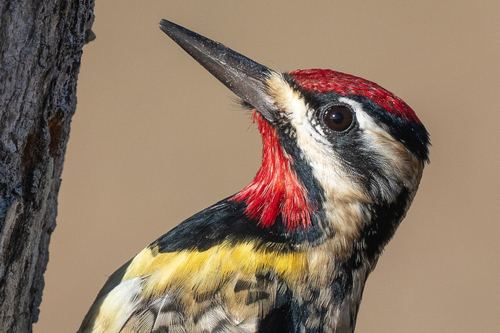
Yellow-bellied Sapsucker
The Yellow-bellied Sapsucker (Sphyrapicus varius) is a North American woodpecker known for its unique foraging behavior. Unlike most woodpeckers that primarily hunt for insects within tree bark, sapsuckers drill orderly rows of shallow holes, called sap wells, in tree trunks to feed on the sap and the insects attracted to it. This behavior plays a crucial ecological role, as the sap wells provide a food source for other animals, including hummingbirds, bats, and other insects. Culturally, they are sometimes considered a pest due to the damage they can inflict on trees, although this is often overstated.
18-22 cm
Length
34-40 cm
Wingspan
Least Concern
Conservation Status
Distribution
Breeds across Canada, the northeastern United States, and the Appalachian Mountains. Winters in the southeastern United States, eastern Mexico, Central America, and the Caribbean. Migrates through eastern North America.
Lifespan
Up to 7 years in the wild (though typically shorter). Not Evaluated in captivity.
Yellow-bellied Sapsucker's Habitat
Habitat Types
Deciduous forests, Mixed forests, Coniferous forests, Orchards
Climate Zones
Temperate, Boreal
Adaptations
Strong, sharp beak for drilling into trees. Specialized tongue with brush-like tip for collecting sap.
Variations
No recognized subspecies, but slight regional variations in plumage and size have been observed.
Appearance
Breeding Plumage
Breeding plumage is more vibrant. Males have a red forehead and throat, while females have a red forehead but a white throat. Non-breeding plumage is slightly duller.
Seasonal Feather Changes
Minor changes; plumage may be slightly duller and more worn in the non-breeding season.
Sex Based Plumage Differences
Males have a red throat, while females have a white throat.
Notable Features
Bold white wing stripe, Black and white barred back, Yellowish wash on belly (often faint)
Diet and Feeding
Primary Foods
Tree sap, Insects, Fruits, Berries
Foraging Behavior
Drills rows of sap wells in trees, returns to feed on sap and trapped insects. Also gleans insects from bark and foliage, and occasionally eats fruits.
Specializations
Specialized tongue with brush-like tip for efficiently collecting sap. Strong beak and skull adapted for drilling.
Seasonal Diet Variations
Relies more on sap and insects during the breeding season. Consumes more fruits and berries in the fall and winter.
Behavior
Social Structure
Generally solitary or in pairs during the breeding season. May form small flocks during migration and in winter.
Communication
Drumming on trees, A variety of calls, including a nasal 'mew' and a 'churr', Visual displays, such as raising the crown feathers
Migration
Migratory, with most individuals moving south for the winter. Migration is nocturnal.
Territorial or Group Behaviors
Territorial during the breeding season, defending nesting and feeding areas. Will drum to mark territory.
Conservation
Threats
Habitat loss (deforestation), Pesticide use (affecting insect prey), Climate change (potential shifts in habitat suitability)
Protection Programs
Protected under the Migratory Bird Treaty Act in the United States and Canada.
Local National Laws
Migratory Bird Treaty Act
Population Trend
Stable
Population Estimates
Global population estimated at 14 million individuals.
Interesting Facts
They create sap wells in over 1,000 different species of trees and woody plants.
This wide range of host trees demonstrates their adaptability.
Other animals, such as hummingbirds, often feed at sapsucker wells.
This makes them a keystone species in some ecosystems.
They can drum at speeds of up to 25 times per second.
Drumming is used for communication and territorial defense.
Faqs about Yellow-bellied Sapsucker
Are Yellow-bellied Sapsuckers harmful to trees?
While they do create holes in trees, they rarely cause significant damage to healthy trees. They often target trees that are already stressed or diseased.
How can I attract Yellow-bellied Sapsuckers to my yard?
Planting native trees and shrubs, especially those with soft wood, can attract sapsuckers. Providing a source of fresh water can also be helpful.
How can I tell the difference between a male and a female Yellow-Bellied Sapsucker?
Males have a red throat. Females have a white throat.
Copyright @ Nature Style Limited. All Rights Reserved.
 English
English